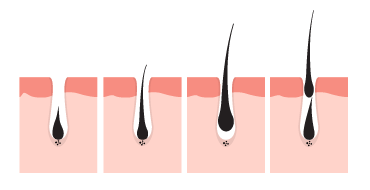Understanding the Hair Growth Cycle
Your hair is complex. Have you read our last post about the structure of an individual hair strand? We uncovered the reason why you may be experiencing frizz or why certain styling products or tools may or may not work for your specific hair type. In this post, we’re diving a bit deeper to uncover the four phases of the hair growth cycle and how it affects the overall appearance of your hair and how your new hair grows in.
The Four Stages of the Hair Growth Cycle

There are four phases of the hair life cycle 1) Anagen 2) Catagen 3) Telogen and 4) Exogen. During these four stages, the hair will grow in and fall out over the years. Each hair enters the individual phases at different times, that’s why your hair doesn’t naturally have the look of a straight, blunt cut when you let it grow out. So, let’s uncover what the purpose of each phase is below.
The Growing Phase – Anagen
During the first part of the hair growth cycle, your strands enter the Anagen stage, which is essentially where your hair root divides and grows. This stage can last anywhere from two to seven years, depending on your genetics. Your hair is being fed nutrients from the bloodstream, so make sure you are eating foods rich in b-vitamins, iron, and zinc, which all promote healthy hair growth.
The Transition Phase – Catagen
When the anagen phase comes to an end, your hair follicles shrink and receive the signal to detach from its blood supply in the scalp. This is considered the catagen phase and typically lasts between ten to fourteen days. While we consider all hair to be dead, there is still some life beneath the surface of the skin. When the catagen phase takes over, the hair, including what’s beneath the surface, dies completely and lays dormant. We call these “Club Hairs.” You can spot these hairs by seeing if the based color has lightened. At any given moment, 10-15% of the hair on your head may be club hair.
The Resting Phase – Telogen
The catagen phase is followed by the telogen phase, where a new hair growth cycle starts beneath the sleepy club hair. During this three-month phase, you’ll notice more shedding. In fact, you can lose up to 50-100 hairs per day. Unfortunately, when you’re experiencing extreme stress, your hair can prematurely enter the telogen phase, and that is when you may start to notice excessive shedding and thinning of the hair. Consult a doctor or physician if you are experiencing this.
The New Hair Phase - Exogen
Finally, the last stage of the hair life cycle, exogen, is when your hair continues to shed and get replaced by new hair growth. To many, this phase is considered an extension of the resting stage, telogen. Once the exogen phase is complete, the cycle begins again at the anagen phase.
So, now that we understand the normal functions of the hair growth cycle, we can quickly determine when things don’t seem right. For example, if you start to notice shedding above the norm of 50-100 hairs per day, you may want to consult a doctor to see what the cause is. Remember to take time throughout the day to relax and breathe. High levels of stress have a significant impact on your hair health, so always be sure to treat your body and mind first, and your hair should follow suit.
Nutrifuse by Pro|Gen
Here at Nutrifuse, we bring you monthly hair tips and tricks to ensure you know how to properly care for your hair or detect when something is wrong. Be sure to check out our full line of restorative hair care products designed to mend and revive dry, damaged hair. Find us on social media @progennutrifuse

